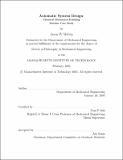| dc.contributor.advisor | Nam P. Suh. | en_US |
| dc.contributor.author | Melvin, Jason W. (Jason Webley) | en_US |
| dc.contributor.other | Massachusetts Institute of Technology. Dept. of Mechanical Engineering. | en_US |
| dc.date.accessioned | 2005-05-19T15:26:18Z | |
| dc.date.available | 2005-05-19T15:26:18Z | |
| dc.date.copyright | 2003 | en_US |
| dc.date.issued | 2003 | en_US |
| dc.identifier.uri | http://hdl.handle.net/1721.1/16957 | |
| dc.description | Thesis (Ph. D.)--Massachusetts Institute of Technology, Dept. of Mechanical Engineering, 2003. | en_US |
| dc.description | Includes bibliographical references (p. 205-209). | en_US |
| dc.description | This electronic version was submitted by the student author. The certified thesis is available in the Institute Archives and Special Collections. | en_US |
| dc.description.abstract | Axiomatic design is investigated as a design methodology for large or complex system design. Particular considerations of system design are described and the suitability of axiomatic design for such considerations is discussed. Then, tools to enable successful application of axiomatic design to systems are developed. The tools are expressed as theorems for axiomatic system design. The first theorem describes conditions for equivalence of FRs, and helps define the relationships within a design matrix. The second theorem describes a method of using only leaf levels to represent a system, and re-sequencing the design to achieve a decoupled matrix. Therefore, some types of coupling at high levels may be reduced or eliminated. The third theorem defines the decomposition strategy that is necessary to make axiomatic design compatible with object-oriented simulation models that are created starting with the high levels of the decomposition. The fourth and fifth theorems present a new method for considering and increasing system robustness to external noise factors during the conceptual design phase. While techniques for increasing robustness to external noise factors are known, integrating them into axiomatic design has not been shown previously. A case study of the design of a machine tool system for polishing silicon wafers using chemical mechanical polishing (CMP) is presented. The CMP system architecture is decomposed from top level requirements using the principles of axiomatic design, and the theorems developed in this thesis. The CMP system was designed and fabricated at MIT by a team of students, and has demonstrated excellent capability to remove material from the surface of a wafer while offering increased control of the removal profile. | en_US |
| dc.description.statementofresponsibility | by Jason W. Melvin. | en_US |
| dc.format.extent | 209 p. | en_US |
| dc.format.extent | 3067201 bytes | |
| dc.format.extent | 3066867 bytes | |
| dc.format.mimetype | application/pdf | |
| dc.format.mimetype | application/pdf | |
| dc.language.iso | eng | en_US |
| dc.publisher | Massachusetts Institute of Technology | en_US |
| dc.rights | M.I.T. theses are protected by copyright. They may be viewed from this source for any purpose, but reproduction or distribution in any format is prohibited without written permission. See provided URL for inquiries about permission. | en_US |
| dc.rights.uri | http://dspace.mit.edu/handle/1721.1/7582 | |
| dc.subject | Mechanical Engineering. | en_US |
| dc.title | Axiomatic system design : chemical mechanical polishing machine case study | en_US |
| dc.type | Thesis | en_US |
| dc.description.degree | Ph.D. | en_US |
| dc.contributor.department | Massachusetts Institute of Technology. Department of Mechanical Engineering | |
| dc.identifier.oclc | 53371559 | en_US |
